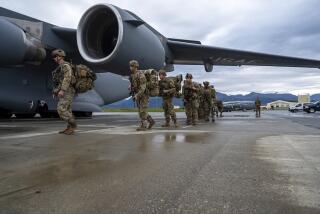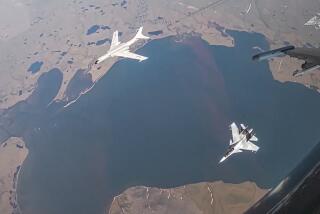Navy Warms Up to Idea of Presence in Cold Bering Sea
SAN DIEGO â In what the commander of the Pacific Fleet calls âa major shiftâ in operations, the Navy has for the first time begun regular deployment of aircraft carrier battle groups in the Northern Pacific to meet a growing Soviet presence in the waters off Alaska.
In recent weeks, Navy personnel have intercepted Soviet surveillance missions off the Alaskan coast, conducted amphibious assault exercises and test-launched a Tomahawk cruise missile near the Aleutian Islands for the first time, said Adm. James A. Lyons Jr., commander-in-chief of the Pacific Fleet.
âWeâve got a message to send (to the Soviets),â Lyons told The Times in an interview here Friday. âWhen we intercept their strike bombers hundreds of miles before they ever get to a weapons launch position, theyâve got to know they ainât ever gonna get there. And if they take that message back, then weâve raised the deterrence equation without firing a shot.â
Virtually Ignored
For decades, the icy Northern Pacific waters were virtually ignored by Navy battle groups as they steamed from San Diego, San Francisco and Seattle on six-month deployments to Hawaii, the Philippines and south to the Indian Ocean.
In recent months, however, the Soviets have increased the number of aircraft exercises in the Bering Sea near the U.S. Adak Naval Air Station in the Aleutian chain, Lyons said.
In response to the âsubstantialâ Soviet threat, Navy Secretary John F. Lehman Jr. said last week that Alaskan waters will become a staging area for regular naval exercises and the Adak naval base will be built up. The exercises will include regular tours by carrier battle groups, which consist of an aircraft carrier and a number of support ships, including cruisers and destroyers.
âAlaska is now a fundamental part of our naval strategy because of a growing economic importance and military importance that is manifest by, first and foremost, the presence of Soviet ships in your waters now on a continuing basis that was never there before,â Lehman told the Commonwealth North organization in Anchorage on Monday. âThe Soviets were smarter than we were as a government in recognizing the importance of this area and the Northeast Pacific and the Pacific Rim. We have been very slow to do so.
âThe myopia of the past policies so totally focused on the Middle East and on Europe.â He added that the Navy is no longer dominated by what had been a âstrong natural bias on the East Coastâ to look eastward.
Lyons also acknowledged that the Navy has been lax in recognizing the importance of the Northern Pacific.
âSea Line of Communicationâ
âPeople tend to overlook that we take more oil out of (the Alaskan port of) Valdez than we import from the Middle East,â Lyons said. âAlso, thatâs a very important sea line of communication for us. . . . The shortest route to Japan (from the West Coast) comes within 50 miles of Adak. . . .
âIâm sure the Soviets have taken note of this as well. Thatâs why theyâre doing as much of their operations as they have done.â
So far this year, the Navy has made 34 ship visits to Alaska, Lyons said, compared to eight port calls in all of 1985. He added that many more fleet exercises in the Northern Pacific are planned.
During these maneuvers, the Navy has encountered numerous Soviet ships and aircraft, Lyons said.
On June 30, the nuclear-powered guided missile cruiser Long Beach launched a Tomahawk missile with a dummy warhead in the Aleutian Islands. The successful launch marked the first time that the Navy had fired a Tomahawk missile from a ship on a regular deployment exercise outside an established missile range. The missile took 75 minutes to reach its target approximately 560 miles away on Kanaga Island.
At the time of the launch, two Soviet attack planes were spotted north of the Long Beach, although they were not in a position to observe the firing, Navy officials said. Air Force F-15 fighter planes from Elmendorf Air Force Base intercepted the Soviet aircraft and escorted them away from the Long Beach.
Amphibious Assault Exercise
The missile test was followed in the first week of July by an amphibious assault exercise in the Northern Pacific involving 11 ships and 5,500 sailors. The operation, conducted in severe weather conditions, consisted of live firing and combat operations on Adak Island. Major units taking part included Destroyer Squadron 13 from San Diego and a Marine amphibious unit from Camp Pendleton.
Within the past week, a battle group led by the nuclear-powered aircraft carrier Carl Vinson--consisting of 12 ships and 80 aircraft--conducted routine flight operations in the Bering Sea for two days. According to Navy sources in Washington, several Soviet aircraft were spotted tailing the Vinson during the voyage.
âI donât mind them coming out conducting surveillance flights at all,â Lyons said of the Soviets. âThey did provide a lot of free services to the air wing on the Vinson, which we greatly appreciate.â
Lyons was referring to Soviet planes giving U.S. pilots an opportunity to track enemy aircraft in the Northern Pacific instead of having to conduct simulated exercises. Lyons called the Vinson deployment a success, in part because the battle group eluded Soviet detection while it was in the Bering Sea, although it was picked up by Soviet aircraft at other times.
The new emphasis on the Northern Pacific will bring changes for West Coast-based sailors who will be sent to Alaska and for Navy personnel assigned to desolate Adak Island.
When the Carl Vinson left Alameda Naval Air Station on Aug. 12, the battle group went straight to the Northern Pacific, bypassing normal stops at Pearl Harbor in Hawaii and Subic Bay in the Philippines.
Lyons said sailors can expect to periodically miss out on popular Hawaii and Philippine port visits because of the new importance placed on the Northern Pacific. That is one way, he said, that the Navy will add the Northern Pacific patrols but minimize time lost in deployment to tropical areas.
Harsh Conditions
Once they reach Alaskan waters, sailors often will encounter unusually cold temperatures and weather conditions marked by strong winds and violent storms. Visibility in the Aleutian Islands during summer months is often less than two miles due to heavy fog, and the temperatures drop to single digits in the winter.
Sailors accustomed to working in the warmer climate of the South Pacific will have to learn new tricks, such as utilizing exhaust heat from jet engines to defrost the flight deck before takeoffs, Navy officials said.
âWe found when we went up there in the early â80s that we werenât equipped to go up there,â said one Navy spokesman in Washington. âYouâve got to take snow shovels along and different types of foul weather gear. The ships, the men and the machines werenât used to operating in that type of environment.â
Said Lyons: âWe need to give the fleet more training and presence there, and operating in the Bering Sea with its difficult weather conditions is a good beginning. We improve our readiness by demonstrating our flexibility. On one part of the deployment, weâre operating up in the Arctic. On another part of the deployment, weâre down in the tropics. It just across the board improves the readiness of our forces and specifically our personnel.â
For the Navy personnel who will be assigned in the future to beef up the naval air station at Adak Island, the transition will be even more drastic.
For years, military officials sent âour real bozosâ to Adak to endure frigid winters while watching over a small squadron of anti-submarine aircraft, said one Navy spokesman in Washington.
Today, Navy officials are calling Adak âa new frontier.â Lyons described Adak as the âKeslavik of the Atlantic.â Keslavik Naval Air Station in Iceland is considered one of the militaryâs key installations because of its strategic location near major Soviet shipping lanes.
âExpanding Our Operationsâ
âWeâve been expanding our operations at Adak with periodic deployment of tactical aircraft . . . and some submarine upkeep,â said Lyons, who last week visited Adak.
During his two-day visit, Lyons said, Soviet ships were spotted gathering intelligence in the Gulf of Alaska. Lyons said he would like to see more U.S. aircraft permanently assigned to Adak.
âThereâs a lot of pressure to make Adak a front-line installation,â the spokesman in Washington said. âQuite an effort is being made to upgrade facilities. We need quality people to support the fleet.â
Many of the 1,750 Navy personnel assigned to Adak leave their families behind because of the climate and an acute shortage of housing and school facilities.
âWe want to make Adak more attractive from that standpoint and upgrade schools so we can get people who will come up with families to live there,â said Cmdr. Jim Mitchell, a Pacific Fleet spokesman based in Hawaii. âAdak is not a nice place to live, Iâm told. . . . Everybody recognizes what we have to do to Adak.â
The Navy entourage accompanying Lyons learned firsthand how harsh conditions can get in the Aleutian Islands, even in the middle of summer. The group was met last week by cold temperatures and freezing horizontal rain, which canceled a fishing trip.
âSomeone said they saw the sun once,â Lyons said.
More to Read
Sign up for Essential California
The most important California stories and recommendations in your inbox every morning.
You may occasionally receive promotional content from the Los Angeles Times.










